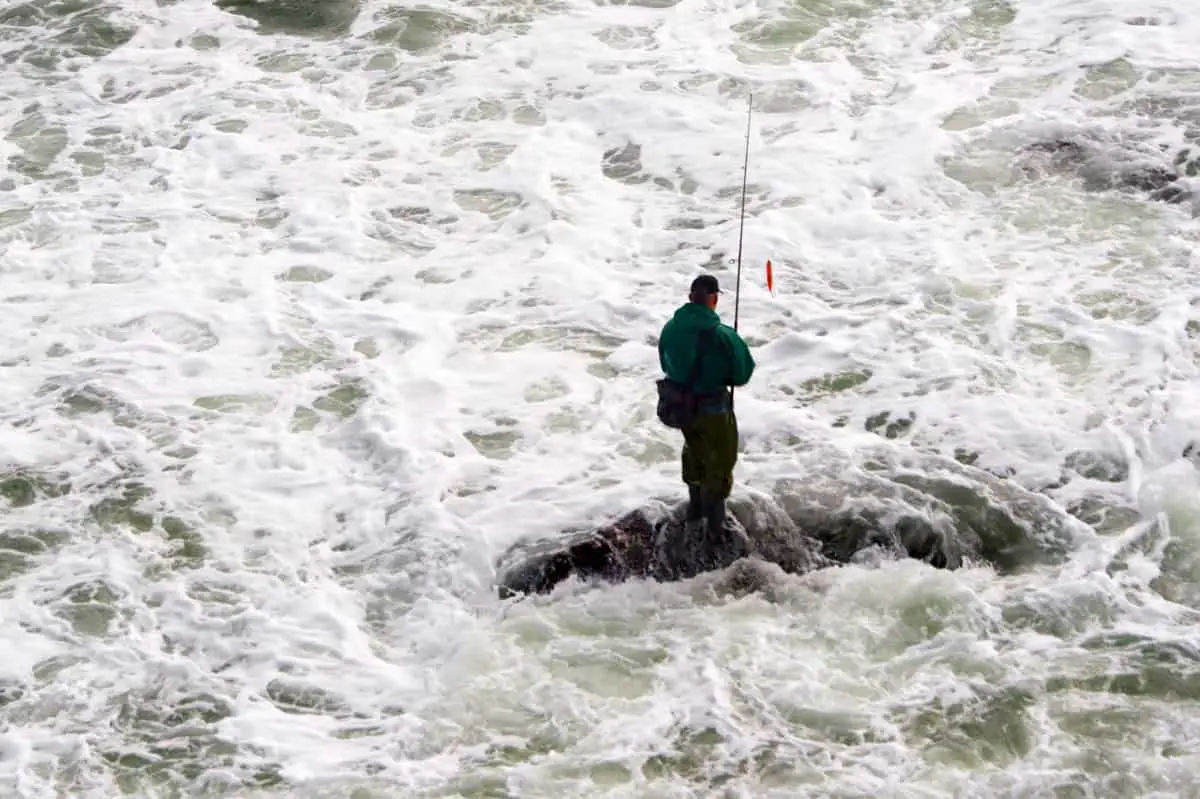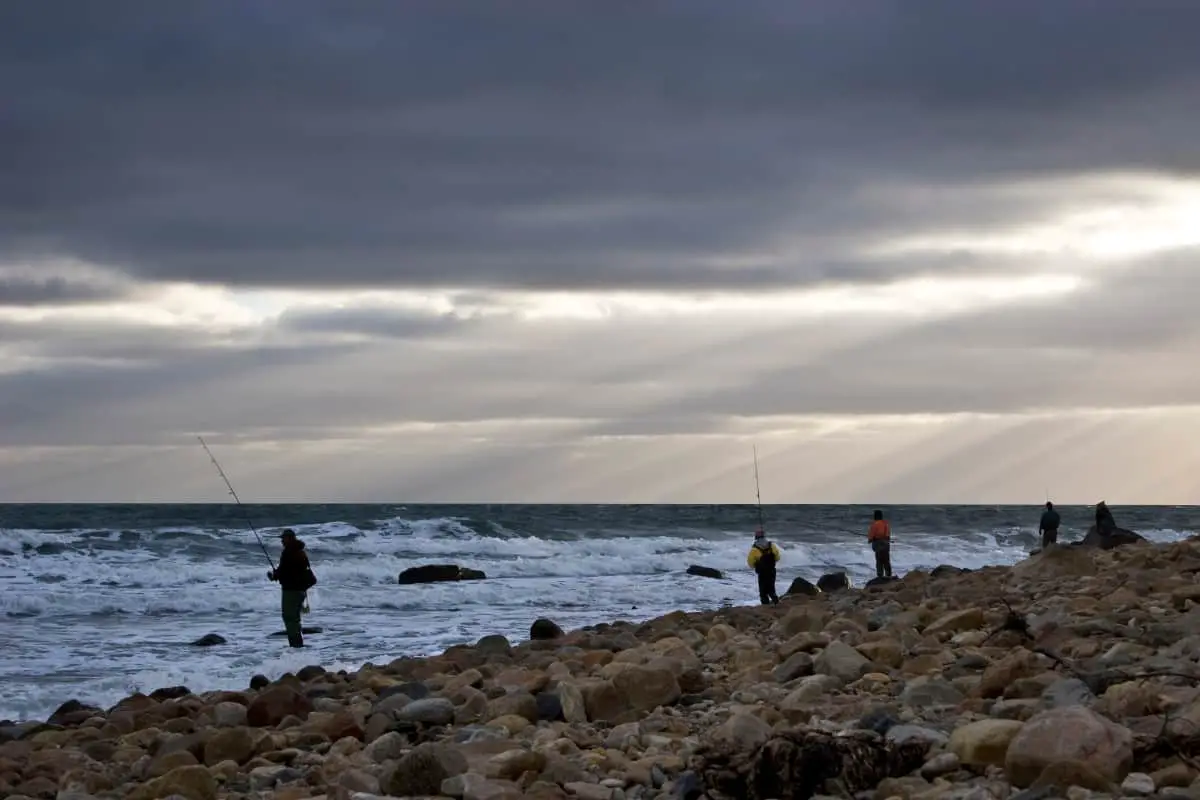There are many fishing techniques, including hand-gathering, angling, spearfishing, trapping, electrofishing, basing, dredging, and even destructive methods like blast fishing. Unfamiliar as some of those may be, surfcasting and surf fishing are familiar.
What is the difference between surfcasting and surf fishing?
Surf fishing is the form of fishing where the angler is standing onshore or in the surf on the edge of the water. Surfcasting is the casting technique based on familiar casting principles, but with different equipment and body, mechanics to generate distance with the entire body.
Surf fishing is familiar and foreign, involving different equipment, body mechanics, locales, species, and options. Is it for you? Here are some basics to get you started.
Surf fishing Equipment And Baits
Surfcasting is usually done with long rods. A surf fishing rod![]() may range from 9 to 15 feet long and include a spinning reel of 20-lb to 25-lb line.
may range from 9 to 15 feet long and include a spinning reel of 20-lb to 25-lb line.
Terminal tackle options include leaders somewhat stronger than your mainline and lead sinkers up to six ounces.
There are a wide variety of surf fishing rig options, including Fish Finder Rigs, Hi-Low Rigs, and Carolina Rigs. Surf fishing baits are species and location-specific.
Surf anglers after bull redfish and sharks may use pieces of mullet, small tuna, stingray, or even bonito. Anglers chasing smaller fish may use frozen shrimp, cut bait, or squid. Artificial bait options include spoons, plugs, and mullet-imitation lures.
Surfcasting techniques
Casting Principles
A surf fisherman uses two-handed casting techniques to ensure long-distance casts into saltwater. Surfcasting is often done with the entire body, as opposed to the angler’s hands and arms.
There are several unique fundamentals of a surf fishing cast, while others are familiar to anglers of all kinds. Here are some basics:
● Your lure will travel in the same direction as the tip of your rod was traveling when its motion ceased
● The most efficient cast involves starting slowly then accelerating to reach top speed at the end of your rod just before you stop
● Once you reach maximum acceleration at the end of your rod, stop your motion quickly and without dropping the tip of your rod from your target trajectory (because your lure will travel in the same direction as your tip was pointing at the time motion stopped)
● Physics generally dictates that the longer your stroke, the more you will load your rod with energy and, all things being equal, the farther your cast will reach
Casting techniques

The Grip
Begin your cast with your rod and line hands close together to prevent any slack from getting into the line. Slack will interfere with fully loading your rod. Place fingers in front of the reel stem, and behind.
With your right index finger, lift the line and move your hand backward, leaving only your right index finger in front of the stem. Pull the lineup and back while pressing gently against the stem, not the line.
The Stance
The slingshot stance unique to surfcasting started with your weak foot forward and pointed directly at your target.
Your dominant foot should be placed behind you and roughly thirty degrees to the right of where you’re aiming.
Keep your feet shoulder-width apart. Only a proper stance will allow full rotation of your hips through your cast.
Dangle your lure approximately two feet below the tip of your rod. While bending your knees a little bit, lock your elbow in place while rotating your hips and shoulders to move the tip of your rod directly back.
Hinge your wrist and bring the rod to rest with your rod hand at ear-level. Don’t send your rod hand past your rear shoulder.
Imagine a clock face and try to have your rod hand forearm aiming at approximately 1:00. Before beginning the cast, shift your weight to your dominant back foot.
Casting
Beginning slowly and starting your motion with your elbow, start your cast. Keep your right arm aligned with the shift in your weight and the rotation of your body so that.
If your arm gets ahead of your body, you won’t generate maximum power since you’ll be relying only on your arm.
On the other hand, if your arms get ahead of your body, your rod trip will drop early, and you’ll lose the tension and power stored in the loaded rod.
The casting motion consists of pushing upward with your right hand while pulling down on the left hand.
That combination of motions speeds up the rod while moving the butt end of the rod perpendicular to your target. You reach maximum speed when your right arm reaches approximately 75% extension, and you half-break your wrists.
At that maximum speed point, stop your motion — abruptly and suddenly — when your rod is at about the 11:00 position. At the same time, you’ll release the line while your full weight is on the toes and ball of your front non-dominant foot.
What Species Are Targeted With Surf Fishing?
On the United States’ west coast, surf casters pursue fish like the Corbina, Spotfin Croaker, Surfperch, California Halibut, Leopard Shark, Soupfin Shark, and Seven-Gill Shark.
On the east coast, surf casters chase striped bass, bluefish, redfish, black drum, tautog, flounder (fluke), bonito, tuna, mackerel, and sharks.
Tournament Casting
You’re familiar with fishing tournaments, of course. Surf fishing brings a whole new sort of tournament to the fore: surfcasting tournaments. What would any fishing-related activity be without someone keeping a record?
The current world record holder for long-distance surfcasting is Danny Moeskops, with a cast of 313.46 yards.
Skishing
Surf fishing and surfcasting have birthed an extreme sports version of itself called Skishing. Skishers don a wetsuit and flippers to swim into the saltwater hundreds of yards while porting a pole to catch fish.
Skishing![]() is the invention of Montauk, New York cabinet maker Paul Melnyk. Melnyk combined the words skiing and fishing to name the sport “skisking.”
is the invention of Montauk, New York cabinet maker Paul Melnyk. Melnyk combined the words skiing and fishing to name the sport “skisking.”
When naming the sport, he was thinking about being towed through the water by a hooked fish large enough to tow him.
Beach Casting
In Britain, anglers have developed their spin on surf fishing and surfcasting that they refer to as beach casting![]() . Like surf fishing, beach casters use rods for up to 16 while standing on the beach or shore.
. Like surf fishing, beach casters use rods for up to 16 while standing on the beach or shore.
Beach casters use water-filled floats, lead weights, and bait, such as mussels, lugworms, ragworms, and squids. Casting techniques in Britain include an overhead cast, and off-the-ground cast, and the Pendulum cast capable of reaching up to 300 yards.

